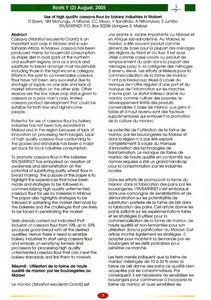| dc.contributor.author | Siyeni, D. |
| dc.contributor.author | Mahungu, N.M. |
| dc.contributor.author | Mhone, A. |
| dc.contributor.author | Moyo, C. |
| dc.contributor.author | Sandifolo, V. |
| dc.contributor.author | Nthonyiwa, A. |
| dc.contributor.author | Jumbo, S. |
| dc.date.accessioned | 2019-12-04T11:19:03Z |
| dc.date.available | 2019-12-04T11:19:03Z |
| dc.date.issued | 2005 |
| dc.identifier.citation | Siyeni, D., Mahungu, N., Mhone, A., Moyo, C., Sandifolo, V., Nthonyiwa, A. & Jumbo, S. (2005). Use of high quality cassava flour by bakery industries in Malawi. Roots, 9(2), 7-11. |
| dc.identifier.uri | https://hdl.handle.net/20.500.12478/3385 |
| dc.description.abstract | Cassava (Manihot esculenta Crantz) is an important root crop in Malawi and in sub-Saharan Africa. In Malawi, cassava has been produced mainly for household consumption as staple diet in most parts of the northern and southern regions, and as a snack and substitute to bread amongst most households including these in the high-income category. Efforts in the past to commercialize cassava flour have not been very successful due to shortage of supply on one side and lack of market information on the other side. Other reasons are the low value crop status given to cassava as a poor man's crop, limited cassava product development that could be suitable for both low and high-income people. Potential for use of cassava flour by bakery industries has not been fully exploited in Malawi and in the region because of lack of innovation on processing technologies. Lack of high quality cassava flour conforming to the grades and standards has been a major set back for local industries consumption. To promote cassava flour in the bakeries IITA/SARRNET has embarked on creation of awareness and demonstration on the potential of substituting partly wheat flour in bread making. The purpose of this paper is to highlight the experiences that have been made and strategies to be followed in commercializing high quality unfermented cassava flour for use by bakeries in MalawI. The paper also highlights strategies to be followed in sustaining the market demands by the bakeries and the challenges that are likely to be faced in penetrating the market. Tests already carried out indicated that inclusion of cassava flour from 10% up to 33% produces good bread with all the desired qualities. Hence there is need to sensitize bakery industries to start using cassava flour and embark on sensitizing farmers and processors for processing high quality unfermented cassava flour that can meet the bakery standards and link them to markets. |
| dc.language.iso | en |
| dc.language.iso | fr |
| dc.subject | Household |
| dc.subject | Cassava |
| dc.subject | Markets |
| dc.subject | Cassava Flour |
| dc.subject | Bakeries |
| dc.subject | High Quality Unfermented Cassava Flour |
| dc.subject | Wheat Flour |
| dc.subject | Industries |
| dc.title | Use of high quality cassava flour by bakery industries in Malawi |
| dc.type | Journal Article |
| dc.description.version | Peer Review |
| cg.contributor.affiliation | International Institute of Tropical Agriculture |
| cg.coverage.region | Africa |
| cg.coverage.region | Southern Africa |
| cg.coverage.country | Malawi |
| cg.authorship.types | CGIAR single centre |
| cg.iitasubject | Livelihoods |
| cg.iitasubject | Domestic Trade |
| cg.iitasubject | Food Security |
| cg.iitasubject | Nutrition |
| cg.iitasubject | Handling, Transport, Storage And Protection Of Agricultural Products |
| cg.iitasubject | Plant Production |
| cg.iitasubject | Markets |
| cg.iitasubject | Value Chains |
| cg.iitasubject | Smallholder Farmers |
| cg.iitasubject | Cassava |
| cg.iitasubject | Post-Harvesting Technology |
| cg.iitasubject | Agribusiness |
| cg.accessibilitystatus | Open Access |
| local.dspaceid | 95059 |

